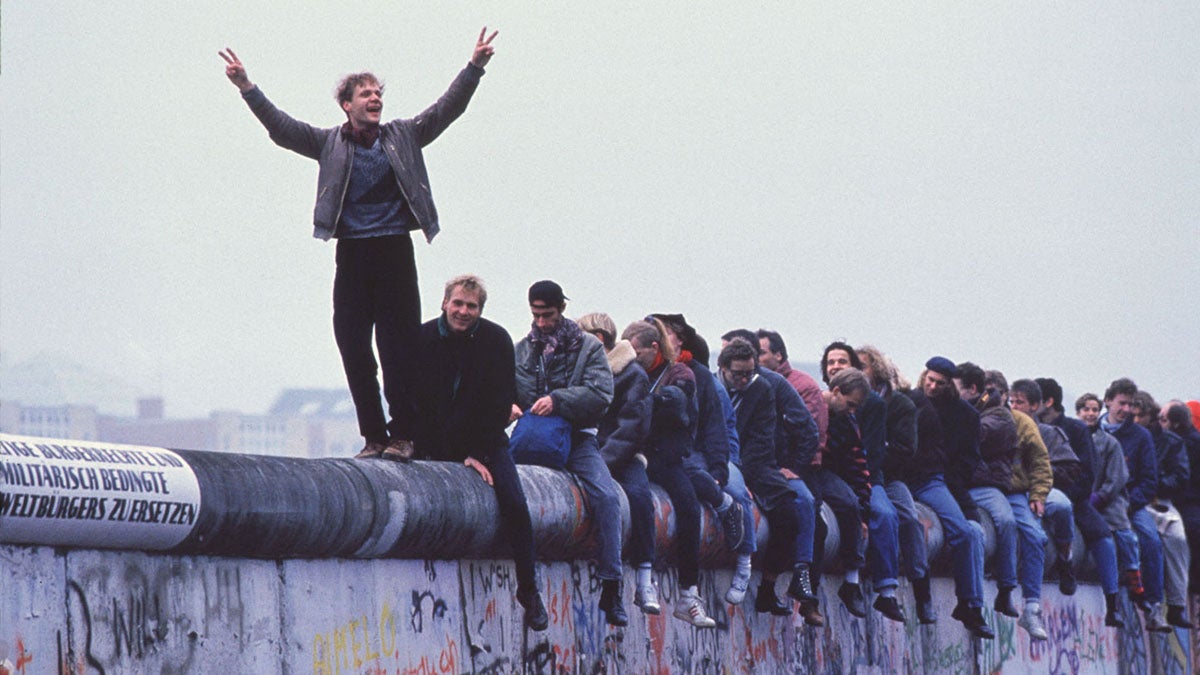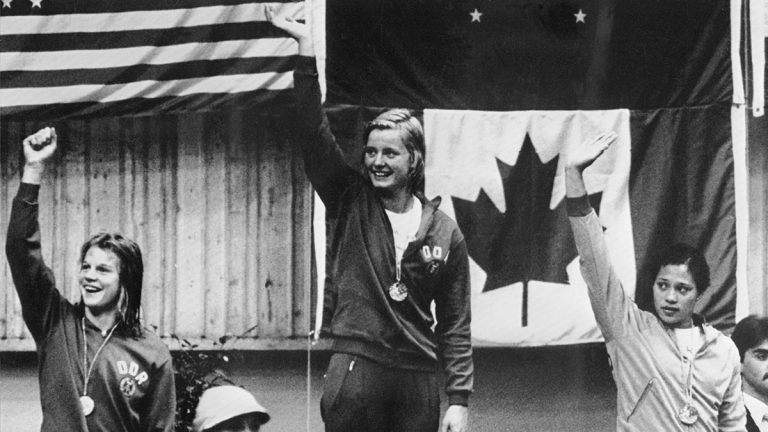Fall of Berlin Wall brought curtain down on GDR's doping program
Why this matters
When the Berlin Wall fell on Nov. 9, 1989, it marked the end of one of the largest and most successful state-sponsored doping programs. Today, a look at doping behind the Wall. Tomorrow, survivors of the GDR doping program. Friday, how regulators are trying to end state-sanctioned doping
![]()
It is the 1976 Olympics in Montreal. The German Democratic Republic (GDR) is en route to collecting 40 gold medals and 90 medals in total. That drug-assisted feat puts the highly controlled communist state of just 17 million citizens second overall in the Summer Games medal count behind the Soviet Union, a high-water mark it repeated in Moscow (1980) and Seoul (1988).
The title of Jerry Kirshenbaum’s 1976 Sports Illustrated story encapsulates the prevailing perception of sports in East Germany: “Assembly Line for Champions.”
For true believers in the ultimate triumph of Marxism-Leninism, it would be hard to imagine then that both the GDR and its powerful athletic machine would come to an abrupt and unceremonious end just 13 years later.
Nov. 9, 2019 marks the 30th anniversary of the fall of the Berlin Wall. That seminal 1989 event sparked East Germany’s reunification with West Germany, as well as the demise of communism in the Soviet Union and its other Eastern Bloc satellite states. The Berlin Wall was built by the East German government in August 1961 to seal off East Berlin from the part of the city occupied by the three main Western powers after World War II to prevent mass illegal immigration to the West.
Confessions from coaches and doctors, whistleblower revelations and the opening of the Stasi archives sealed East Germany’s infamy for creating the most comprehensive state-sponsored doping system in the history of international athletics.
What is evident today is that modern Germany, despite having done considerable penance for the horrors of the Nazi regime and World War II, has struggled with how best to confront the tainted achievements and body-destroying effects of elite GDR sports.
State Plan 14.25, secretly launched in 1974, mandated the systemic use of performance-enhancing drugs for East German Olympic aspirants, including some pre-pubescent children. It was authorized by GDR sports minister Manfred Ewald, a former Hitler Youth leader, and implemented by Dr. Manfred Hoeppner, the state director of sports medicine, and the nation’s top scientists. The East Germans had already been doping since the 1960s.

The objectives were multi-dimensional. East Germany treated sports as a vehicle to show the superiority of socialism over capitalism, divert attention from its underperforming economy, and provide an independent source of national pride without jeopardizing its security in the Warsaw Pact military alliance. Victory — even if achieved illegally and without consideration for individual human rights — was all that counted.
Anabolic steroids — euphemistically dubbed “supplementary means” — drove the doping program. Jenapharm, an East German pharmaceutical company that still exists today, developed Oral-Turinabol. Approximately 2 million doses of synthetic testosterone were given annually to 2,000 GDR athletes, frequently without their knowledge, as the little blue pills were passed off as “vitamins.” More than 10,000 athletes were doped.
GDR doctors strove to ensure drug cheating went undetected, using methods that ranged from administering epitestosterone to keep athletes’ hormone levels within IOC-sanctioned limits to swapping dirty urine for clean urine. In fact, only in 1977 did 20-year-old shot putter Ilona Slupianek became the first East German athlete ever caught doping during competition.
The 5-foot-10, 205-pound product of SC Dynamo Berlin tested positive for steroids at the European Cup in Helsinki and was suspended for a year. In 1980, however, Slupianek returned to win gold at the Moscow Olympics, which were boycotted by the U.S. and other Western countries after the Soviet invasion of Afghanistan. She also set two world records that year.
Female East German athletes were disproportionately subjected to doping. It was less of an effort to spotlight women’s sports under socialism than a cold-blooded calculation to reap medals that were tougher for East German men to win against elite Western competitors.
Title IX legislation, which stipulated gender-equal access to sports at American colleges and universities, was not signed into law until 1972. Thus, at this time, U.S. women athletes, as a group, were not undergoing as rigorous training as their East German counterparts. Prevailing standards of femininity and beauty also discouraged Western women from getting overly big and strong.
Ewald and Hoeppner ruthlessly exploited the opportunity they had identified. According to Mark Johnson’s Spitting in the Soup: Inside the Dirty Game of Doping in Sports, “GDR researchers knew that one-third of their female athletes were suffering gynecological damage from heavy anabolic steroid use.”
The steroid-fueled 1976 East German Olympic women’s swimming team won 11 of 13 possible gold medals. The American team, starring Shirley Babashoff, settled for one upset gold in the 4 x 100 relay. When the 18-year-old Babashoff called out her GDR rivals for their “deep voices and mustaches” and refused to shake hands with them, the media dubbed her “Surly Shirley.”
The post-Berlin Wall fallout from the state-sponsored doping program, which confirmed the accusations of Babashoff and suspicions of others, is incredibly mixed and problematic. For one thing, the IOC has consistently declined to confiscate or reallocate medals won by East German athletes who were later shown to be doping if they did not test positive at the Olympics in question.
In 1976, 17-year-old East German Kornelia Ender became the first female swimmer ever to win four gold medals at one Olympics. According to the Plauen native, she did not know she was being doped at the time, and she retired in 1977 when she found out that was the case. Ender has retained her medals. On the other hand, Ender’s teammate Carola Nitschke volunteered to return her medals and asked for her name to be removed from the record books.
World records set by Eastern Bloc women have proven hard to topple, despite subsequent advances in training, athletic gear, nutritional knowledge, and other factors. One example is Marita Koch’s seemingly impregnable 400-meter record of 47.60 seconds at the 1985 International Association of Athletics Federation (IAAF) World Cup in Canberra, Australia. Koch never admitted doping, never failed a drug test, and kept her record. She has had a low-key retirement, running a sporting goods store in Rostock.
However, researchers Brigitte Berendonk and Werner Franke found information in the Stasi archives about specific doses of PEDs reportedly given to Koch and other track and field athletes. The Independent’s Simon Turnbull noted: “They also unearthed a letter from Koch to Jenapharm complaining that Barbel Wockel, who won the European 200m title ahead of her in Athens in 1982, was being given stronger doses of the steroids because her uncle was president of the pharmaceutical company that fed the East German athletics regime.”
Today’s female sprinters have complained that not only are many world records out of reach, but that their unattainability reduces excitement around women’s athletics. Of course, doping existed and continues to exist in men’s athletics as well, but Victor Conte, whose San Francisco-based BALCO lab featured in the drug scandal implicating Barry Bonds and other pro athletes, has stated that steroids can help a female 100-meter sprinter shave 0.4 seconds off her time, versus just 0.2 for a male sprinter.
Meanwhile, GDR swimmer Kristin Otto has stayed in the spotlight after retirement, despite controversy about her achievements. In 1988, she became the first woman to win six gold medals at one Olympics. Otto has said she never knowingly took PEDs, although Franke has contradicted that assertion based on his research.
In 1997, there was an outcry over Otto’s nomination — in light of her murky past — to become the president of the German Olympic Association, and she withdrew from consideration. In 2013, Swimming World Magazine revoked the World Swimmer of the Year awards originally given to Otto and other East German stars. Still, the 53-year-old Leipzig native remains a swimming commentator on the German TV network ZDF.

When punishment finally came for the state-sponsored doping masterminds, it was lenient. In 2000, Ewald and Hoeppner faced 142 counts apiece of being an accessory to causing bodily harm in a Berlin court. Ewald got a 22-month suspended prison sentence and died two years later at age 76. Hoppner also got probation.
Today, Western athletes like Babashoff are still waiting for upgraded medals, apologies, or other forms of restitution that may never come. The IOC, IAAF, and other governing bodies remain reluctant to re-open a can of worms from the past.
The victimized East German athletes have received some financial compensation. In 2006, 167 of them got about $12,000 apiece from the German government. A second fund, expected to assist more survivors, was set up in 2016, with an application deadline of Dec. 31, 2019.
There is a widespread reticence about re-examining the East German experience, which is viewed as a paranoid and shabby chapter in German history. Resentment between former West Germans and East Germans continues over the latter group’s struggles to integrate into a capitalist economy.
Selective memories are rampant. To frame the issue in cinematic terms, it is easier to watch an Ostalgie comedy, like Goodbye, Lenin!, than a harsh reminder, like The Lives of Others, that shows how one in seven East Germans spied on their neighbors. Critical reappraisal is often hardest for the former GDR citizens and sportspeople themselves.
As Gary Bruce wrote in The Firm: The Inside Story of the Stasi: “There is a self-defense mechanism at play against what appears to East Germans to be a suggestion that because the country in which they lived was the country of the Stasi and the Wall, their triumphs, achievements, personal relationships, even their lives were all for naught.”
However, this is all such recent history that the bodies of the East German doping survivors still provide living testimony to what happened. Some of those athletes may still be among us 30 or 40 years from now. Their fates should not be allowed to disappear into obscurity like those syringes in the St. Lawrence River.
Lucas Aykroyd writes for the New York Times, espnW, and the Women’s Sports Foundation. Based in Vancouver, he has covered women’s hockey at five Winter Olympics and four IIHF Women’s World Championships.





